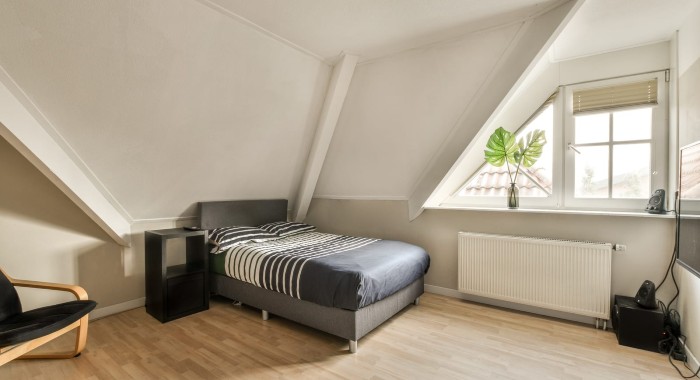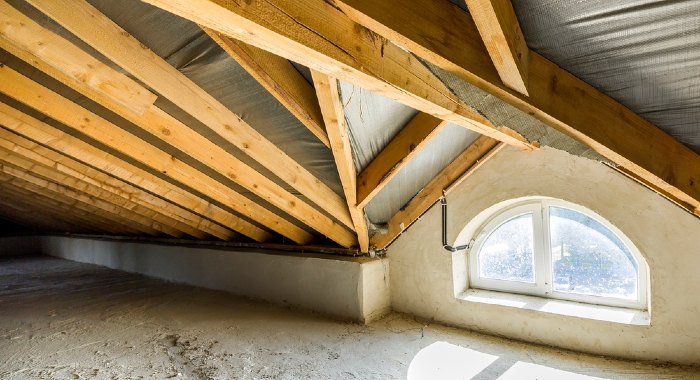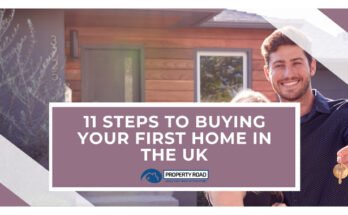Finding your dream home is such a great feeling, which can make it difficult to think practical. But if you are buying a house with a loft conversion, it pays to be cautious.
Extensions and loft conversions are a great way to add more space to a house. While it can bring upheaval and costs money, it can make a beloved home grow with you.
So it’s likely that at some point in your house hunt you will come across a house with a loft conversion. You might even fall in love with one.
We have seen many homes with converted loft spaces during our various house hunts, and we bought one. So in this guide to buying a house with a loft conversion, we will tell you all you need to know.
What to look out for when buying a house with a loft conversion

While a property with a loft conversion can provide you with the space that you need, there are things that you need to consider before signing on the dotted line.
In most cases, buying a property with a converted loft space won’t cause problems, but sometimes it can. And to avoid extra costs or your dream home turning into a nightmare, it’s important to look out for the following things:
- Planning permission
- Building regulations
- Impact on mortgage
- Badly designed conversion
Let’s look at each of these in more detail…
Planning permission
The first thing you should establish is whether the conversion needed planning permission and if so, if it received it. The majority of loft conversions don’t require planning permission, as they fall under permitted development, as set out in the government guidelines.
We found the easiest way to find out is to ask the seller directly. However, the seller is legally obliged to provide information on any extensions or conversions that have been carried out anyway. Your solicitor will review the information received, and query missing information.
If planning permission was not needed, then that’s great. If planning permission was needed and granted, the seller will be able to provide the relevant documentation to your solicitor.
It’s worth checking that the actual conversion matches planning permission to avoid any issues in future. If you are concerned, talk to your solicitor, who can advise you.
When we bought our previous home, the vendor did get planning permission for the loft conversion, but it was a bit confusing. They seemed to have made changes after the initial permission was granted. This led to our solicitor believing that the permission didn’t match the conversion.
After some back and forth, we contacted the seller to find out what the issue was. She explained that they did get permission for the changes, but for some reason it wasn’t with the same case number.
We looked at all the planning documents regarding the house and came to the conclusion that everything was OK. But to be honest, it was all quite a mess.
So as you can see, even if planning permission was needed and granted, it’s still worth checking everything carefully.
The real problem arises when planning permission was needed but not sought or not granted. In this case, you are buying a house with an authorised loft conversion.
Dealing with an unauthorised loft conversion

So what’s the issue? Well, if the local authority has not approved the conversion, they could ask you to pull it down. This can be costly, but it also means you lose the space.
While you might be able to rebuild it, either under permitted development or with planning permission, it will cost you quite a bit. And there is no guarantee that you will get planning permission, if it is needed.
You might wonder how likely it is that the local authority will make a claim against you. This often depends on how long ago the conversion has been built. The longer it is in place, the less likely they are to ask for it to be pulled down.
But you should be aware that the risk will always be there. However, there are things you can do.
1. Retrospective planning permission
If the conversion was unauthorised there are two routes you can go down. First you can ask the seller to request retrospective planning permission. Or if they refuse, and you don’t want to lose the house, you can do this yourself.
However, there is no guarantee that you will get it. And it will cost, because there is a fee for applying for retrospective planning permission. It’s also possible that they ask you to make alterations, which might be costly.
Worst case scenario, they might order you to pull it down. Not the ideal prospect, right?
2. Indemnity insurance
The second route you can only take if you have not already taken the first: get indemnity insurance. While this won’t protect you from the local authority to make a claim, it will cover your costs.
So you might still lose the space, but at least you won’t be out of pocket. The important thing to consider is that you can’t speak to the local authority about the conversion, as this would invalidate the insurance.
Even if you don’t apply for retrospective planning permission, just inquire to see if it might be granted.
Neither of the two routes is perfect, because the risk of having to pull it down will always be there. But as we have said: the longer the loft conversion is in place, the less likely you will be asked to pull it down.
Your solicitor will be able to advise you on the best route to take, if you want to go ahead buying this house with a loft conversion.
Building regulations

Another important factor to look out for when buying a house with a loft conversion is building regulations. Every conversion needs to be registered with the local authority and be built according to building regulations, or building regs as they are often called.
Among other things, building regs compliance ensures that the conversion is structurally safe. So it’s quite an important thing.
The seller will be asked for the building regulations certificate as part of the conveyancing process. If they provide it, then all is good. But if they can’t, then this is cause for concern.
It could be that the conversion wasn’t done by the seller but by a previous owner and the seller didn’t get the certificate when they bought the house.
If there is no building regs certificate, two things might have happened:
- The loft conversion wasn’t done according to building regulations
- The loft conversion is compliant, but a certificate was never applied for
The second scenario is fairly easy to resolve: the conversion needs to be registered with the local authority retrospectively and a certificate applied for. This can be done by the seller or by the buyer after the sale has been completed.
When we bought our house with a loft conversion, there was no building regs certificate. While the sellers did build the conversion according to building regulations, they didn’t finish it, so couldn’t get a certificate.
The only thing that was missing were vents in the two shower rooms. Once they were installed, a certificate would be issued. When we asked the seller if she would be prepared to install them, she refused.
After getting some quotes for the work, we decided that the costs involved weren’t very high. So we decided to do it ourselves, as we really loved the house.
We contacted the local authority and got a written confirmation that once the vents were installed, we could get a certificate. Which we did and after an inspection we received the certificate.
But the first scenario is more complex and potentially a big issue.
Dealing with a non-compliant loft conversion

Buying a house with a loft conversion that doesn’t comply with building regulations brings some challenges with it. The first is the question of safety.
Building regs compliance will ensure that the loft conversion is structurally safe. This is vital, after all, you don’t want it to collapse on you or your children falling through the floor, right? So the first thing to establish is if it’s structurally sound and safe.
This is done by arranging for a survey to be done. We would recommend a building survey, as it focuses on the safety of the loft conversion.
1. Loft conversion isn’t deemed safe
If the survey finds that the conversion isn’t safe and potentially dangerous, it’s decision time. You can ask the seller to carry out the work recommended in the building survey. This could be some alterations or a complete rebuild.
This scenario would mean you delay the purchase, which could have consequences. You could lose your buyer. The seller could lose their onward purchase. And this could lead to the chain collapsing.
Alternatively, you could renegotiate the sales price to give you the money you need to carry out the work yourself.
After the work has been carried out, by the seller or you, a Letter of Regularisation can be obtained from the local authority. This is basically getting a building regs certificate retrospectively. The advantage here is that you can be sure all is now in order and as it should be.
Or you can decide to walk away. Your solicitor will be able to advise you on the options open to you at this point.
2. Loft conversion is deemed safe

The other scenario is that the surveyor concludes that although the loft conversion isn’t compliant with building regulations, it’s safe. This doesn’t mean that the conversion is done well (we get to this later), but you can be sure that it won’t collapse.
Again you have to make a decision. You can get indemnity insurance, which will cover you for any costs that might arise in future if any issues occur. This is only an option if the conversion is safe though, because the insurance won’t pay if it collapses because it wasn’t safe.
The insurance can be taken out either by the seller or you as the buyer, as it’s attached to the house. So if you sell the house, the insurance gets passed on to your buyers.
The good news is that indemnity insurance isn’t expensive, so even if the seller refuses, it won’t add much to your costs. It’s also worth knowing that the local authority only has one year from the completion of the conversion to demand alterations or it being pulled down.
Indemnity insurance might not be an option if you need a mortgage, as the lender could refuse to lend you on a house with a non-compliant loft conversion.
Another way to deal with it is not using it as a bedroom. A non-habitable loft conversion doesn’t need building regs. However, this means you are losing a bedroom, which means you might be overpaying. This could cause issues with your mortgage lender if you have one. More on that later though.
It’s a great reason to renegotiate the sales price though. Especially, if the seller has advertised the space as a bedroom. You could then use the money you save to alter or rebuild the loft conversion to meet building regulations.
This way you can get either a Letter of Regularisation or a Building Regulations Certificate, and all is in order.
Before making a decision, speak to your solicitor and get their advice. You might also want to ask about the implications of the options with regard to reselling the property. The chances are that you will sell the house at some point in the future.
Getting a mortgage

If you are a cash buyer, then buying a house with a loft conversion that is unauthorised and/or non-compliant is much easier. That’s because your funding doesn’t rely on a third party. As long as the conversion is safe, indemnity insurance for both planning and building regs is a viable option.
It’s still advisable to speak to your solicitor though and get their advice.
But if you need a mortgage, it gets a bit more complicated. The lender will want to ensure that they will be able to recover their investment in case you can’t pay back the mortgage.
So if it turns out that the loft conversion doesn’t have planning permission and/or building regs, you should contact your lender immediately. How they react will depend on their own policies and how strict they are. These are some of the scenarios:
- Requires you to get retrospective planning permission and/or building regs
- Requires you to get indemnity insurance (and possible a survey report to confirm it’s safe)
- Refuses to lend to you
- Down value the property
If the things your lender asks for aren’t possible for some reason, you can look for a different lender. A mortgage broker will be able to help you find a lender that will give you a mortgage for the house.
However, a specialist lender might have higher rates, so this is something to keep in mind. In case of a down valuation, you can try to renegotiate with the vendor. If successful, you might have the funds to alter or rebuild the loft conversion to be compliant.
The last resort will be to walk away and pull out of the sale.
Buying A Property? FREE Step-By-Step Platform
Living with a badly done loft conversion

Buying a house with a loft conversion can be a challenge. And even if you have jumped all the hurdles, you might end up with a converted loft that has issues, even if it has a building regs certificate.
This means you have to live with a badly done loft conversion, which isn’t always a piece of cake. We know that only too well. Despite our loft conversion having had planning permission and building regulations sign-off, we had issues.
The main issue was that it didn’t seem to have been insulated very well. As a result, the loft space would get really hot in summer. It was our master bedroom, so summer nights weren’t as restful as they should have been.
Because the room was south-facing, the roof warmed up during the day and then released the heat during the night into the room. Even if we opened the windows during the night, it wouldn’t cool down much.
We had to sleep in the guest room during hot periods because the main bedroom was just too warm to get a good night’s rest. This was quite an issue, but there are other potential problems you might have to live with:
- Not enough head height – you might have to duck or bend
- Inconvenient stairs – they might make the downstairs smaller
- Too dark – the windows might not be sufficient to light up the room
- Noisy – the room might not be well sound-insulated
- Proportion issues – the rooms might not work for what you want
The latter is another issue we had. Well, not at first. When we bought the house, the layout of the loft conversion worked great for us. But when we came to sell it, we realised that it made the house difficult to sell.
There were two rooms in the loft space, both with en-suite. One was a very large room, the master bedroom. The other was quite small, more like a single bedroom. We used the smaller bedroom as a dressing room, and it worked great.
But when we put the house on the market, we realised that the layout put many people off. Our house was a dormer bungalow. It had some bedrooms and the family bathroom downstairs and the two rooms in the loft conversion.
Older people looking for a bungalow didn’t like it that the main bedroom was upstairs. Young families didn’t like it that there was only one small room upstairs. While it might work for a nursery, later it wouldn’t any more.
We sold the house in the end, but we had to wait for the right buyer and he took his time.
As you can see, living with a converted loft space that has been badly done can bring up some challenges. And it’s something you should think about before buying a house with a loft conversion.
Selling a house with a loft conversion

If you are buying a house with a loft conversion, the chances are you will, at some point, be selling a house with a loft conversion. All the things we have discussed here will come into play again.
However, if your conveyancing solicitor has done a good job, you should have all the documentation in place you need to sell the house. Make sure you keep them in a safe place.
There are some things to consider though. If you have dealt with an unauthorised and/or non-compliant loft conversion by getting indemnity insurance, you are likely to face the same issues as your seller.
Some buyers will be put off by the lack of approval. Others might face issues with their lender and potentially withdraw.
Getting retrospective planning permission and building regs is the only way to make the sale of the house smoother. And if you can do this, great. If not, it won’t stop you from selling the house, but be prepared for it to be more challenging and maybe take longer.
Conclusion
So, should you buy a property with a converted loft space? The answer is, yes, if it’s the right house for you. While there are some things to consider when buying a house with a loft conversion, in most cases, any issues can be resolved.
The most important thing is to get all relevant information, so you can decide how to deal with any concerns. Your solicitor will help you with this. They can also give you advice on how to proceed.
A survey can also help unearth potential issues with the conversion, and is especially recommended if the seller can’t provide a building regs certificate. The surveyor will also be able to tell you if planning permission had been needed.
From our own experience we can say that any alteration to a house, such as an extension or a loft conversion, might cause issues. But if you get your dream home, it’s worth the hassle.





